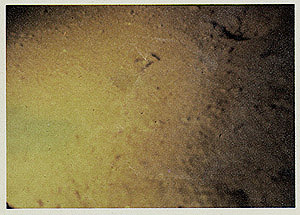by Dick Raynor
The 1972 Academy of Applied Science - Loch Ness Investigation Flipper Pictures examined, old assertions questioned and new explanations proposed.
Thirty years have now passed by since the famous "Flipper Pictures" were taken during a joint Academy of Applied Science (AAS) and Loch Ness Investigation Bureau (LNI) project at Loch Ness, and they are still frequently presented in the media as evidence for the existence of monsters. I was a crew member on the L.N.I. boat on the night of 7th-8th August 1972 when the pictures are believed to have been taken, and I was directly involved with their original publication in U.K. My analysis, published for the first time here, questions their validity as evidence of "monsters".
THE PICTURES
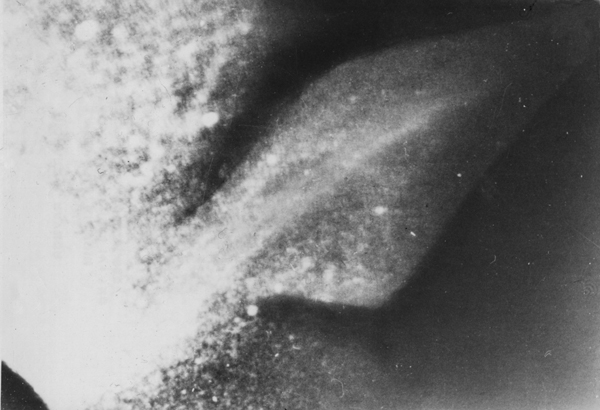
First Image -"Enhanced"
Copyright © 1972 Academy of Applied Science /
Loch Ness Investigation Bureau
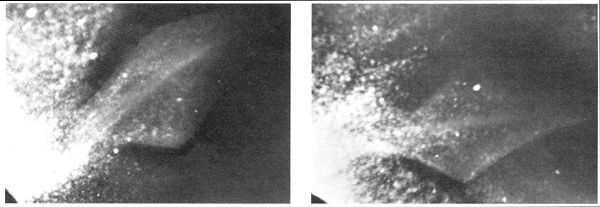
First Image (left) and Second Image taken 45 seconds
later
(as published (2) in MIT Technology Review, March/April
1976 but rotated 180 degrees to correct position)
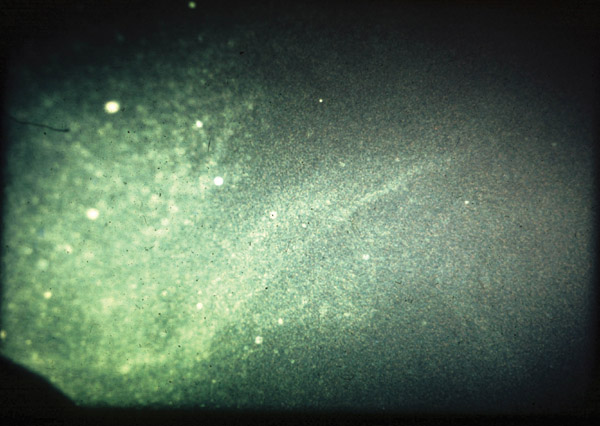
First Image -"Unenhanced".
Copyright © 1972 Academy of Applied Science /
Loch Ness Investigation Bureau
The dark specks and single hair are artefacts on my
copy of the image.
The 35mm Kodachrome transparency of the unenhanced first image and the "computer enhanced" black and white image were sent to me personally by Dr. Rines prior to publication in October 1972, and can be regarded as the work of his Academy of Applied Science team. The "camera original" film used is stated to be 16 mm Kodachrome 11, with an ASA speed rating of 25.
The time-lapse camera could take photographs at a range of time intervals, and is stated to have been set at 45 seconds for this work. Individual frames are not time-stamped, so there is no way of knowing when any particular photograph was taken. I am not aware of any time-specific photographs from the '72 Expedition.
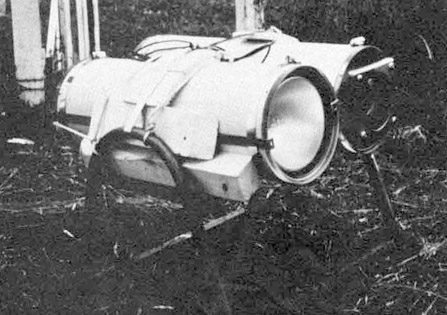
The '72 Camera and strobe rig after assembly at Achnahannet...
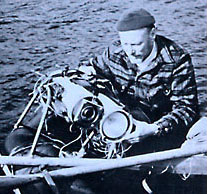
...and one showing the tubes reversed.
As will be seen in the supporting pictures, the separate camera and strobe light tubes were mounted side-by-side on a steel frame, sometimes with the camera on the left and sometimes with it on the right. The camera had a built in feature, possibly related to its origin as a WW2 gun camera, which produced a small dark triangle in the bottom left-hand corner of every picture. This is clearly visible in some of the other images taken by the same camera for calibration purposes that year and also in June 1975 when it recorded the Gargoyle Head sequence. When this small dark mark appears in uncropped published photographs it is always in the bottom left-hand corner - except, that is, in the published versions of the flipper picture! They appear to be usually presented upside down or rotated 90 degrees clockwise. In the interests of consistency I show the pictures the right way round.
THE EQUIPMENT
ARRANGEMENT OF EQUIPMENT (AAS VERSION)
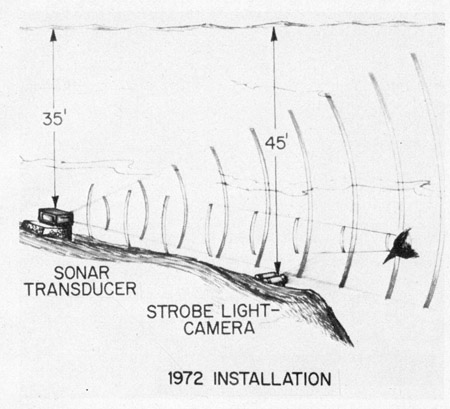
from MIT Technology Review March / April 1976
From the diagram above one would deduce that both the camera - strobe unit and the sonar transducer were installed on the bottom of the loch. This certainly was not the case on the night of August 7th - 8th 1972.
ARRANGEMENT OF EQUIPMENT - RAYNOR VERSION
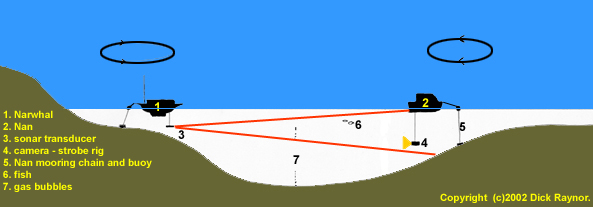
Actual arrangement on night of Flipper Picture
The black circles show the boats were free to rotate
around their moorings
The sonar transducer was attached to a piece of wood
suspended in a horizontal mode about 12 feet beneath the LNI boat "Narwhal",
which was moored to a buoy near the edge of the deeper water (possibly
the the remnants of an old river channel). The camera - strobe unit
was suspended beneath a cabin cruiser called "Nan", which was moored to
a large can buoy usually occupied by an converted motor fishing vessel
called "Golden Harvest" . This mooring was about 120 feet away and the
other side of the deeper channel. This large buoy was held in position
by a heavy chain descending to an anchor on the loch bottom. The camera
and strobe were suspended about 45 feet beneath the surface in their waterproof
housings. The sonar beam is not sharply defined,
but "weakens" by 50% (3dB) outside of the 12 degree nominal coverage,
so strongly reflective targets will be recorded at the appropriate range
even if they are outside the narrow nominal beam width.
BOAT MOVEMENT
Both boats were free to swing on their moorings. Narwhal,
with its relatively low profile and deep keel was more likely to orient
itself with the current which circulates in Urquhart Bay in calm and light
breeze conditions. Nan, with a higher superstructure and less draught tended
to respond more to any breeze that might be around. On the night in question,
the weather varied between calm and a light breeze from a variable direction.
The distance between the boats and their orientation therefore varied all
night and without record.
SONAR EQUIPMENT
The sonar used was a Raytheon DC 725 which used chart
paper and an unusual triple stylus system, with the three styli separated
by 120 degrees. The chart paper used showed a total of five possible
distances for any given echo appearing on the chart, generally with no
sure way of distinguishing between them.
SONAR TARGETS
There are a number of objects which might appear on
the sonar trace from time to time. These should include random gas bubbles
rising from the loch bottom, fish, the loch bottom, Nan's hull, Nan's mooring
chain and buoy, and the twin targets of the strobe and camera tubes
mounted on a tubular steel framework (actually a set of caravan steps from
Achnahannet). These are numbered in the diagram above.
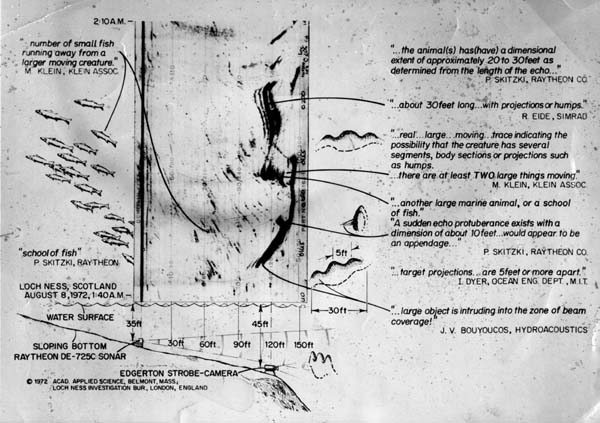
Contemporary Diagram showing proposed interpretation.
DISCUSSION OF PHOTOGRAPHS
FOCUS
In his own publications Dr Rines states that
objects less than four feet from the camera will not be in focus,
and we see this effect in the left hand parts of the unenhanced picture.
I should add that when transparencies are duplicated the colour balance is frequently distorted, and the green colouration is of no significance. The 1975 "Gargoyle Head" pictures were taken using a different film stock and they have a blue background - again not a true representation of the situation in Loch Ness!
LIGHTING
As a technical photographer, I see incongruous features
in the pictures and their presentation.
In the original "unenhanced" picture, the general
impressions is that the lighting is from the left of the camera (it can
only be from the immediate left or from the immediate right) and yet the
black and white "computer enhanced" prints both show drop-shadows beneath
the edges of the "flipper" which are hard to explain other than in terms
of "artistic interpretation" - more usually described as retouching. The
artist or artists responsible have never been identified by the Academy
of Applied Sciences, but the work was clearly carried out prior to publication
in early October 72, as it was contained in the print sent to me by Dr
Rines at that time.
OBJECT ALIGNMENT
As stated above, all indications are that the small
dark patch occurs in the bottom left hand corner of the picture, which
means that the flipper is attached at the bottom left end. If, as suggested
by proponents of the photographs, the picture shows the rear right hand
flipper of an aquatic quadruped, then it would seem to be belly up, and
furthermore, static relative to the camera for at least the 45 second interval
between the two consecutive frames. This, I suggest, is unlikely
behaviour for an aquatic predator.
COMPUTER ENHANCEMENT
At the time of their publication in 1972 much was
made of the use of "computer enhancement" to extract otherwise invisible
detail from these photographs. Manipulation of images by computer back
then was real rocket science - as evidenced by the fact the these images
were said to have been enhanced at the Jet Propulsion Laboratory in Pasadena!
However, I have two observations to make.
Firstly, there is no evidence of pixelation in the flipper pictures circulated at the time. Microscopic examination shows film grain and a few suspiciously straight lines, but no signs of the blocks which are the data in a digital image. This is odd, because Academy of Applied Science enhancements of the Dinsdale Film, done later, did show such evidence.
Secondly, even using modern professional computer software 30 years newer than that at JPL, no-one has managed to reproduce anything resembling the published Flipper Pictures.
AAS Calibration shot of loch bottom with lighting from the left. The obscured corner is at the bottom left, and the sediment at the bottom of the picture is out of focus - it is probably less that 4 feet from the lens. The small crater with a shadow at the top of the picture is sharp.
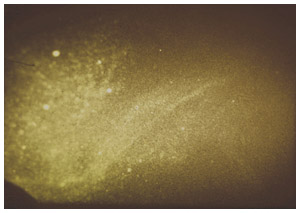
Copyright © 1972 Academy of Applied Science /
Loch Ness Investigation Bureau
First Image unenhanced, but colour corrected.
Note that there is not too much difference between these two pictures. In the calibration shot, the foreground does resemble a "rough textured hide", and the white specks at the left ( which are out of focus) in the First Image could be explained as particles of sediment disturbed when the unit struck the bottom and remained there for over 45 seconds. Note also that both the "flipper" and the "body" to which it would be attached appear to change shape between the first and second images, but do not move relative to the camera.
INTERPRETATION
Given the unrestricted ability of both boats to rotate on their moorings, it seems at least possible that Nan could have swung round towards the shore allowing the camera rig to touch the bottom and remain there for at least 45 seconds. The out of focus area at the top left of the First Image, noticeably absent in the Second Image, could be interpreted as a cloud of sediment stirred up as the rig touched the bottom. 45 seconds later, of course, it would have partially settled again.
SONAR RECORD
The "simultaneous" sonar record used as supporting
evidence at the time of publication of the photographs shows a variety
of targets at slowly changing ranges. This is entirely consistent with
a boat carrying the sonar transducer swinging on its mooring, and "shining"
its sonar beam in a variety of directions. The sonar chart, when the transducer
was pointing towards Nan, should show the boat itself, the anchor
chain, and the strobe camera unit, all slowly getting closer to or further
from the transducer as the boats moved, together with a variety of echoes
from the loch bottom which will vary in distance at a different rate from
the "Nan-associated objects". The sonar chart does show large multiple
targets in the beam at 0144 hrs, and between 0153 and 0202. A version published
elsewhere (1) show similar targets at the same range at 0110, and between
0115 and 0120, but no other photographs were obtained.
If the photographs did indeed show a part of a large
aquatic creature a few feet in front of the camera, and if the sonar record
were simultaneous as claimed then the camera tubes, mooring system and
hull of Nan should also be visible on the sonar record*. It would seem
desirable to identify all of the expected features of the sonar chart first,
(so that they can be eliminated) before attributing any of them to a large
aquatic creature. None of the five (perfectly reputable) authorities studying
the sonar chart for AAS are mentioned as identifying ANY of them.
* If anyone were to argue that the sonar record shows
a monster swimming in front of the camera, so large as to obscure the boat,
mooring and camera rig behind it, I would have to ask why only two photographs
were obtained of it, and where on the chart are the equipment echoes once
it has swum away.
CONCLUSIONS
There is no evidence presented which ties the time of the sonar event with the time of the photographic event, and so no correlation can be assumed.
The original "flipper" photographs do not differ significantly from test shots of the loch bottom.
The enhanced "flipper" photographs show incongruous shadow features which I cannot explain other than as deliberate artistic improvement, i.e."retouching".
The published sonar record and expert interpretations ignore the required presence of the camera equipment, boat and mooring system on the paper record, and the mobile nature of both sonar and camera.
These observations lead me to conclude that any suggestion
that the photographs and sonar record are due to a nearby large aquatic
animal are not supported by the evidence presented.
References
1. Campbell S. The Loch Ness Monster - The Evidence (1996) ISBN 1 874744 61
2. Rines / Egerton / Wyckoff / Klein - Search for the Loch Ness Monster. MIT Technology Review March-April 1976 Massachusetts Institute of Technology
All photographs are Copyright 1972 Academy of Applied Science, Concord. NH USA unless labelled otherwise .
Intellectual Property Rights Assertion. All text Copyright Dick Raynor August 6th 2002.
